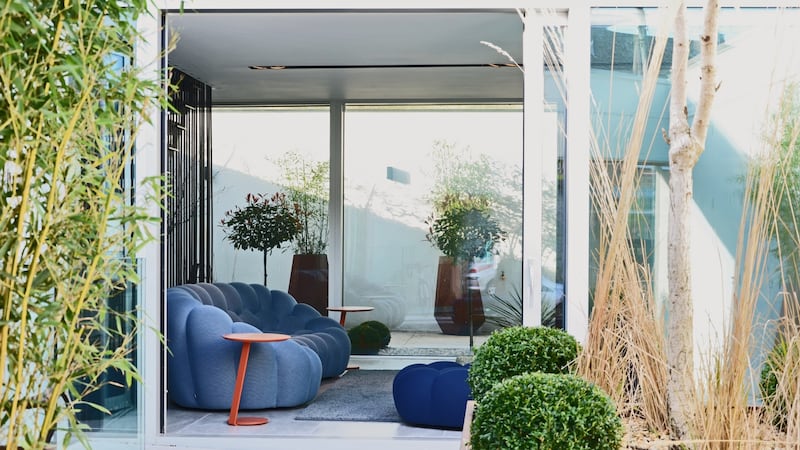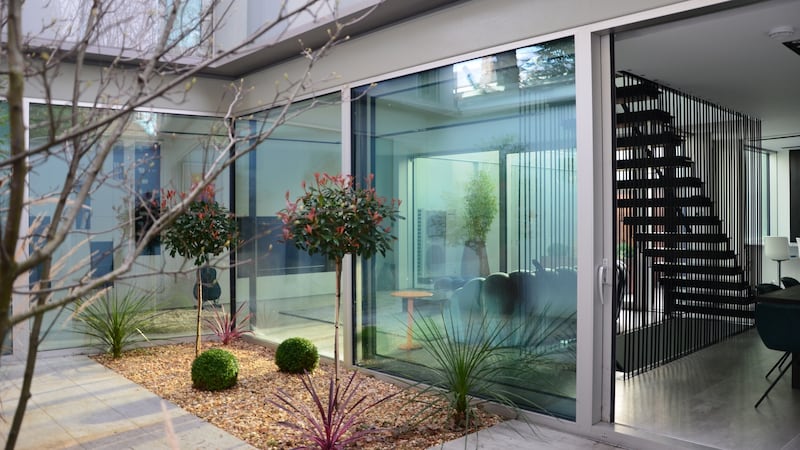A garage that was once used to store a Mini Cooper, measuring only about 150sq m, has been excavated to deliver a three-storey, three-bedroom family home of 180sq m onto the minuscule patch of land.
Peter Crowley is the latest member of RTÉ's Home of the Year judging panel, but off-screen the architect has quietly been creating memorable structures for 15 years, including the entrance to Dáil Éireann on Kildare Street and the mixed-use development Elm Park in Booterstown, which he did with Bucholz McEvoy Architects before leaving to set up PAC Studio Architects with his colleague Graham Petrie, in late 2007, about six months before the economy crashed.
The pair finessed their skills working on commercial buildings, and bring that bigger-scale thinking – especially how a building looks and feels relative to its environment – to the domestic side of the business.


The Rathmines house was their first job. They had designed it, got planning and tendered out the job – and then the crash came. It was 2011 before the client came back to revive it.
The design was all about light and space, Crowley explains. Firstly, he enclosed the site, building a one-storey high redbrick wall around its perimeter, creating a cyclorama curtain effect that screened the living spaces from being overlooked.
It was, he says, understatedly, a complicated build. The space was so tight that the contractor, Ardcourt Buildng and Civil Engineering, had to figure out where to put materials on site mid-construction.
Evening light
The addition of front and back courtyards meant the back, which is east-facing, got morning light and the front of the house, with its westerly aspect, could be bathed in afternoon and evening light.
High-performing glazing is what makes this home stand out from all the other glass houses, says Crowley. “Glazing is more technical than any other material – it is is pure physics to figure out how much heat and light the glass will let in and out,” he explains. The design was modelled in a programme that played with its orientation and how the glass would perform over the course of a year. “The results are unique to the property’s location and would differ if the same design was drafted for a London or Paris address. It shows where the glass may be overheating or underheating and delivers a prescription specific to the property that factors in heat loss, heat thermistance and shading.”
There are various coatings you can put on the glass too. All this adds to the cost, which at about €750 per sq m was about 1½ times his firm’s typical €500 per sq m glazing cost, but the spend on such precise glazing, by Reynaers, delivered a reduction in running costs, Crowley explains.
This thinking that is standard in commercial building, where there is a better understanding of green architecture, is something that will become more important with the impending rise in carbon taxes. Underfloor heating, operated by an electric heat pump, on all floors radiates up from the slabs. The heat pump is positioned in the back garden where it can be screened from view. It does make an audible hum but Crowley, who has one in his own home, says it isn’t enough to bother him.
Emotional warmth
The house opens into the lounge where there is a gas stove, set around sofas by Roche Bobois, but it is really there to create an emotional warmth on a wet winter night when it is nice to physically see a flame, he explains.
A stairwell of steel tension rods, by John Shiel of Stairgate Engineering, Portarlington, divides the livingroom from the diningroom cum kitchen.
A layer of air trapped between the two glass walls helps to further warm the rooms
Patrick McKenna of Wabi-Sabi designed the units and the blackened oak dining table.
The three doubles and family bathroom are on the first floor. Milled aluminium-layered glazing at this level has an inner and outer layer designed so that each panel could adjust opacity and reflectiveness to create a very slick and modern version of the one-way mirror so beloved of cop dramas. It creates a real sense of privacy as well as a flickering effect when viewed from the street, Crowley explains. A layer of air trapped between the two glass walls helps to further warm the rooms.
The sizeable shower in the master ensuite is screened from the period redbrick house to the front of the mews site by mature trees and gives you the feeling of washing in the midst of the woods.
Below ground there is a home office, naturally lit by a sunken courtyard. About 30sq m of space has been given over to housing the plant and tech systems that operate the home.
A house such as this will cost between €2,500 and €3,500 per sq metre and costs are inextricably linked to size, he explains. “The more area, the more costs involved.” These costs exclude VAT at 13.5 per cent and fees.
pacstudio.ie; ardcourt.ie; reynaers.ie; wabisabi.ie
Peter Crowley, along with his co-judge Deirdre Whelan, from RTÉ's Home of the Year, will be appearing at the Permanent TSB Ideal Homes Show, in the RDS, from April 12th-14th, offering advice to people thinking of buying, selling and renovating their homes. idealhome.ie










